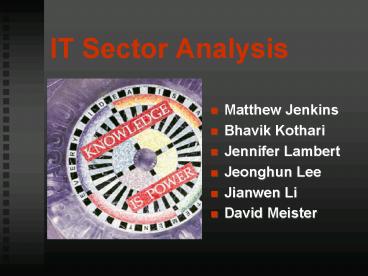IT Sector Analysis - PowerPoint PPT Presentation
1 / 32
Title:
IT Sector Analysis
Description:
Business Analysis: External Factors ... Business Analysis: Profitability Outlook. Low demand, slow upgrade cycles and ... Financial Analysis: Earnings Per Share ... – PowerPoint PPT presentation
Number of Views:154
Avg rating:3.0/5.0
Title: IT Sector Analysis
1
IT Sector Analysis
- Matthew Jenkins
- Bhavik Kothari
- Jennifer Lambert
- Jeonghun Lee
- Jianwen Li
- David Meister
2
Outline
- Size Composition
- Recommendations
- Business Analysis
- Financial Analysis
- Valuation Analysis
- Review Recommendations
- Questions
3
Size Composition
- We are currently underweight (4.02)
- Market Weight 15.96
- Portfolio Weight 11.94
- Industry Composition of Portfolio
- IT Services
- 1.2 of SP
- Concord EFS 5
- 1.83 of Portfolio
- Semiconductors
- 2.8 of SP
- Intel 1
- 4.57 of Portfolio
- Software
- 4.4 of SP
- Microsoft 1
- 4.24 of Portfolio
- Hardware
- 3.45 of SP
- IBM 1
- 1.31 of Portfolio
4
Recommendations
- Maintain underweight position for the sector.
- Strategically look at the industries within the
sector for opportunities - Software
- Hardware
- Semiconductors
- IT Services
- Keep watchful eye for recovery we believe that
we are close.
5
Business AnalysisBusiness Cycle
6
Business AnalysisPhase of Cycle
7
Business AnalysisExternal Factors
- Technological Factors Network externalities and
open standards have led to constant innovation. - Government Federal government defense spending
has grown at a CAGR of 6.96 in the last 5 years
as compared to 2.90 CAGR in the last 10 years.
Defense spending on technology has increased from
2-4 to 8-10 in recent times. - Social Changes Minimal, mainly influenced by
convenience. - Demographics The use of technology is spreading
in various functions within organizations and
across many industries. - Globalization Outsourcing of software services
and BPO activities to India.
8
Business AnalysisDemand Factors
- Growth in GDP Revenue cycle in the IT sector
has been following the trend in the GDP growth
rate.
9
Business AnalysisDemand Factors
- Manufacturing Index ISM Manufacturing activity
index and technology orders have a high
correlation. Current manufacturing index has
dropped to 47, which indicates slowdown in
technology orders. - IT Spending CIO and CFO IT spending survey
results - Most business heads expect a growth of 2-3 in IT
spending in 2003. - Spending critically depends on company
performance and business needs. - Quality service and low cost will influence
spending decisions over innovation. This will
put pressure on profit margins of IT companies. - Hardware purchases are becoming more price
driven. Lengthening of life cycles and
horizontally scaled architecture are the main
reasons for this. - Majority of business heads agreed that IT budget
growth has slowed from 5-7 to 2-4. They have
incentive to under invest. - Spending on storage and software expected to
increase. Short of capacity and software being a
leading indicator of business needs are the
reasons for this. - Long-term growth in IT spending expected to be 5
- 7.
10
Business AnalysisDemand Factors
- Corporate Earnings High correlation between
corporate earnings and IT spending in the past
7-8 years, with a time lag of 1-2 quarters.
11
Business AnalysisSupply Factors
- Capacity Utilization
- Utilization is low for all hardware,
communications and networking equipments compared
to industries in other sectors. - Semiconductor industry is currently operating at
65 capacity utilization. - Capacity utilization of storage devices is very
high mainly due to delay in spending by
businesses in the past. - Technological Innovation
- Intel plans to release the next microprocessor
chip in June 2004. Hence, till then prices of
semiconductor chips are expected to decrease at
the historical rate of 7.
12
Business AnalysisProfitability Outlook
13
Financial AnalysisEarnings Per Share
Forecast
14
Financial AnalysisCF from Operationsby Industry
15
Financial AnalysisAdjusted Free CFby Industry
16
Financial AnalysisNet Profit Margin
17
Financial AnalysisReturn on Equity
18
Financial AnalysisDupont Analysis
19
Financial AnalysisROE by Industry
20
Valuation AnalysisSector P/E, P/B, P/S vs. SP
500
21
Valuation AnalysisSector P/B, ROE Relative to
SP5A
22
Valuation AnalysisSector P/S, NPM Relative to
SP-5A
23
Valuation AnalysisSoftware P/E, P/B, P/S
24
Valuation AnalysisIT Services P/E, P/B, P/S
25
Valuation AnalysisHardware P/E, P/B, P/S
26
Valuation AnalysisSemiconductor P/E, P/B, P/S
27
Valuation AnalysisPrice Momentum
28
Valuation AnalysisCrossover Index
29
Valuation AnalysisSector Dividend Yield
30
Valuation AnalysisSummary
- P/E, P/B, P/S, P/CF point to industry
opportunities, but not overall sector short-term
value - Low (relative to median) ratios suggest value,
high suggest overvalued industry prices. - Technical Analysis suggests sector is close to
reaching its resistance price, but has remained
flat for the past six months. - We will make specific industry recommendations
during the company presentation.
31
Recommendations
- Maintain underweight position for the sector.
- Strategically look at the industries within the
sector for opportunities - Software
- Hardware
- Semiconductors
- IT Services
- Keep watchful eye for recovery we believe that
we are close.
32
Questions?
References Fed Beige report, Merrill Lynch and
Bearn Stein CIO survey and Gartner surveys on
defense spending.































